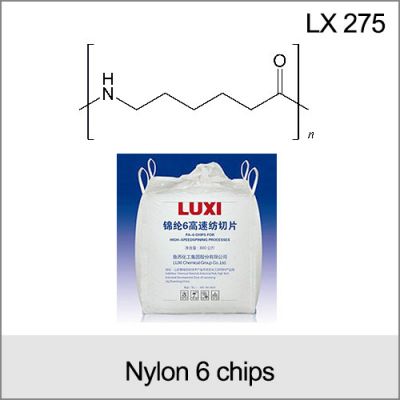Nylon 6
| brand | LUXI |
| Packing | 800KG Bag |
| Wrapped | with Pallet |
| weight per container | 25.6MT |
General Information | ||
Name | Polyamide 6 Chip Bright | |
CAS No. | 25038-54-4 | |
HS Code | 39081012 | |
Chemical Formula | -[ C6H11NO]n- | |
Molecular Weight | 115.1735 | |
Chemical Structure |
| |
Specification | ||
Items | Value | Test Methods |
Appearance Abnormal Chip (grain/100g) | 1 max | FZ/T51004-2011 6.8 |
Appearance Black or Yellow Chip (grain/100g) | 1 max | |
Moisture Content | 0.06% max | FZ/T51004-2011 6.2.1A |
Extractable Matter with Hot Water | 0.5% max | FZ/T51004-2011 6.4 |
Relative Viscosity (25°C,96%H2SO4, m:v=1:100) | 2.75±0.03 | FZ/T51004-2011 6.3 |
Amino Content (mmol/kg) | 43±3.0 | FZ/T51004-2011 6.6 |
Carboxyl Content (mmol/kg) | 55±3.0 | FZ/T51004-2011 6.7 |
Melting Point (°C) | Actual Measurement | DSC |
Packaging | ||
800kg vacuum bag | ||
Transport | ||
UN. No. | NA | |
Hazard Class | Non-hazardous | |
Application | ||
Polyamides 6 or Nylon 6 is widely used in HOY/FDY, civil spinning and industrial spinning material , engineering resins and films.PA6 replace metal in automotive applications such as gears, fittings, and bearings, in automotive industry for under the hood parts. Nylon 6 is also used as thread in bristles for tooth brushes, surgical sutures, and string for acoustic and classical musical instruments, including guitars, sitars, violins, violas, and cellos. It is also used in the manufacture of a large variety of threads, ropes, filaments, nets, and tire cords, as well as hosiery and knitted garments. Electronic appliances such as CD, telephones, computers, videos and so on optic lighting, electronic appliances, mechanical equipment | ||
Storage and Handling | ||
Store in cool, dry and ventilated places away from humid environment, protect vacuum packing. | ||
Firefighting Measures | ||
Use water fog, dry chemical, carbon dioxide or foam as appropriate for materials in surrounding fire. Avoid using direct streams of water on molten burning material as it may scatter and spread the fire. Melts in proximity to fires resulting in slippery floors and stairs. Static charges or on powders or powders in liquids may ignite combustible atmospheres. Airborne dusts of this product in an enclosed space and in the presence of an ignition source may constitute an explosion hazard. | ||



